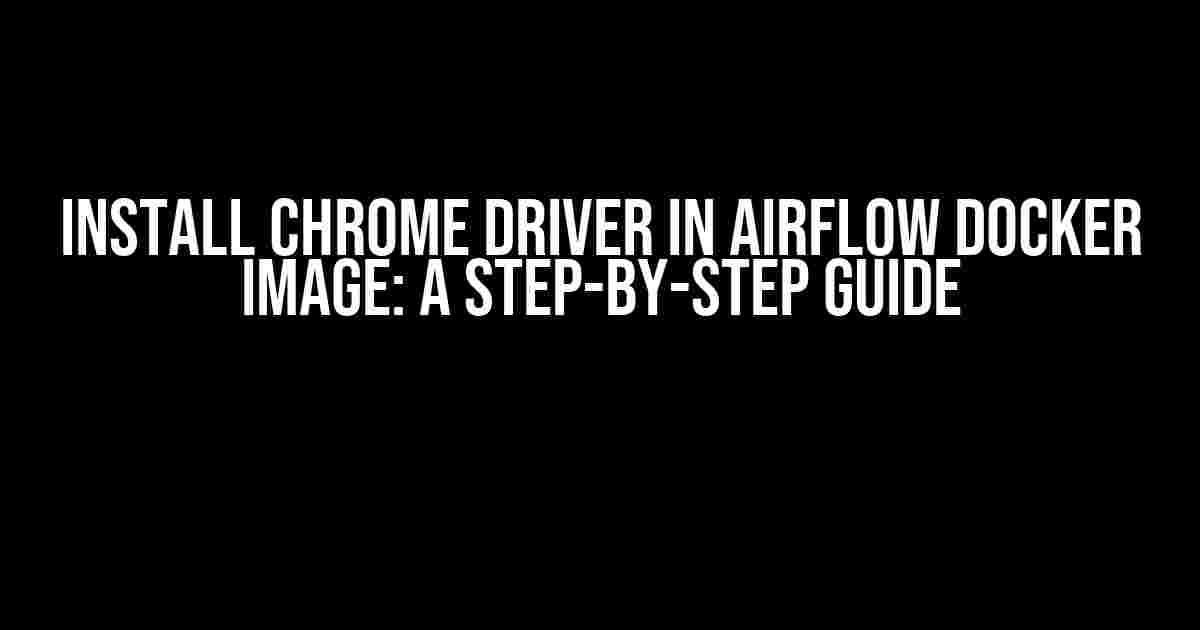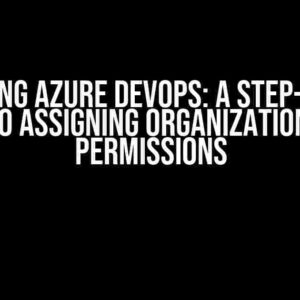Are you tired of struggling to install Chrome Driver in your Airflow Docker image? Look no further! In this comprehensive guide, we’ll walk you through the process of installing Chrome Driver in your Airflow Docker image, allowing you to automate your web scraping and testing tasks with ease.
Why Install Chrome Driver in Airflow Docker Image?
Before we dive into the installation process, let’s discuss why installing Chrome Driver in your Airflow Docker image is essential.
- Selenium Automation: Chrome Driver is a crucial component for automating web browsers using Selenium. By installing Chrome Driver in your Airflow Docker image, you can automate web scraping, testing, and other tasks with ease.
- Headless Browsing: Chrome Driver enables headless browsing, which allows you to run browser instances in the background without displaying them. This feature is particularly useful for automating tasks that require browser interactions.
- Faster Execution: By installing Chrome Driver in your Airflow Docker image, you can execute your automation tasks faster and more efficiently. This is because Chrome Driver can handle multiple tasks simultaneously, reducing the overall execution time.
Prerequisites
Before you begin, ensure you have the following prerequisites in place:
- Docker Installed: You need to have Docker installed on your system. If you haven’t installed Docker yet, download and install it from the official Docker website.
- Airflow Installed: You need to have Apache Airflow installed and running on your system. If you’re new to Airflow, check out our comprehensive guide on installing Airflow.
- Basic Knowledge of Docker and Airflow: You should have a basic understanding of Docker and Airflow concepts, including Dockerfiles, containers, and Airflow DAGs.
Step 1: Create a New Dockerfile
To install Chrome Driver in your Airflow Docker image, you need to create a new Dockerfile. Open a text editor and create a new file named `Dockerfile`.
FROM apache/airflow:2.2.0
# Set the working directory to /app
WORKDIR /app
# Install Chrome and Chrome Driver
RUN apt-get update && \
apt-get install -y chromium-browser chromium-codecs-ffmpeg-extra && \
curl -sS -o chromeedriver.zip https://chromedriver.storage.googleapis.com/2.46/chromedriver_linux64.zip && \
unzip chromeedriver.zip && \
chmod +x chromedriver && \
mv chromedriver /usr/local/bin/
# Set the environment variables
ENV CHROME_BINARY=/usr/bin/chromium-browser \
CHROME_DRIVER_BINARY=/usr/local/bin/chromedriver
# Expose the port
EXPOSE 8080
# Run the command to start Airflow
CMD ["airflow", "db", "init"]
This Dockerfile does the following:
- Uses the official Apache Airflow 2.2.0 image as the base image.
- Installs Chromium browser and Chrome Driver.
- Sets the environment variables for Chrome and Chrome Driver.
- Exposes port 8080 for Airflow.
- Runs the command to initialize the Airflow database.
Step 2: Build the Docker Image
Open a terminal and navigate to the directory where you created the `Dockerfile`. Run the following command to build the Docker image:
docker build -t my-airflow-image .
This command tells Docker to build an image with the tag `my-airflow-image` using the instructions in the `Dockerfile`.
Step 3: Create a New Airflow DAG
To test your newly created Docker image, you need to create a new Airflow DAG. Create a new file named `chrome_driver_dag.py` in your Airflow DAGs directory.
from datetime import datetime, timedelta
from airflow import DAG
from airflow.operators.bash_operator import BashOperator
default_args = {
'owner': 'airflow',
'depends_on_past': False,
'start_date': datetime(2023, 3, 1),
'retries': 1,
'retry_delay': timedelta(minutes=5),
}
dag = DAG(
'chrome_driver_dag',
default_args=default_args,
schedule_interval=timedelta(days=1),
)
t1 = BashOperator(
task_id='run_chrome_driver',
bash_command='chromedriver --version'
)
dag.append(t1)
This DAG does the following:
- Defines a new DAG named `chrome_driver_dag`.
- Creates a BashOperator task that runs the command `chromedriver –version`.
- Schedules the DAG to run daily.
Step 4: Trigger the DAG
Trigger the DAG to test your Chrome Driver installation. Open a terminal and run the following command:
airflow dags trigger chrome_driver_dag
This command triggers the `chrome_driver_dag` DAG, which runs the `chromedriver –version` command.
Step 5: Verify the Installation
Check the Airflow logs to verify that Chrome Driver is installed correctly. Run the following command:
airflow tasks logs chrome_driver_dag run_chrome_driver 1
This command displays the logs for the `run_chrome_driver` task. Look for the Chrome Driver version in the logs to verify that the installation is successful.
| Output | Description |
|---|---|
|
The Chrome Driver version is displayed in the logs, indicating a successful installation. |
Conclusion
Installing Chrome Driver in your Airflow Docker image is a straightforward process that requires minimal setup. By following the steps outlined in this guide, you can automate your web scraping and testing tasks with ease. Remember to verify the installation by checking the Airflow logs for the Chrome Driver version.
With Chrome Driver installed in your Airflow Docker image, you’re ready to take your automation tasks to the next level. Happy automating!
Found this article helpful? Share your feedback and suggestions in the comments section below!
Want more articles on Airflow and Docker? Subscribe to our newsletter for the latest updates and tutorials!
Need help with implementing Airflow or Docker in your project? Contact us for consulting services and let our experts guide you!
Here are 5 FAQs about “Installing Chrome Driver in Airflow Docker Image” in HTML format with a creative voice and tone:
Frequently Asked Questions
Got questions about installing Chrome Driver in Airflow Docker Image? We’ve got answers!
Q1: Why do I need to install Chrome Driver in my Airflow Docker Image?
You need to install Chrome Driver in your Airflow Docker Image because it allows you to run web scraping tasks and automate browser interactions using Selenium. Without it, you won’t be able to automate web-related tasks in your Airflow pipeline!
Q2: How do I install Chrome Driver in my Airflow Docker Image?
Easy peasy! You can install Chrome Driver by adding a few lines to your Dockerfile. First, install the Chrome browser using `RUN apt-get update && apt-get install -y google-chrome-stable`. Then, install Chrome Driver using `RUN curl -sS -o /tmp/chromedriver.zip https://chromedriver.storage.googleapis.com/2.41/chromedriver_linux64.zip && unzip /tmp/chromedriver.zip && rm /tmp/chromedriver.zip && mv /usr/local/bin/chromedriver /usr/bin/chromedriver && chmod +x /usr/bin/chromedriver`. That’s it!
Q3: What version of Chrome Driver should I install?
The version of Chrome Driver depends on the version of Chrome browser you’re using. For Chrome 89 and above, you should use Chrome Driver 89.0.4389.23 or higher. You can check the Chrome Driver version compatible with your Chrome browser version on the official Chromium website.
Q4: How do I configure Airflow to use the installed Chrome Driver?
To configure Airflow to use the installed Chrome Driver, you need to update your Airflow configuration file (`airflow.cfg`) to point to the Chrome Driver executable. Add the following lines to the `[selenium]` section: `chrome_driver = /usr/bin/chromedriver` and `browser = chrome`. That’s it! Your Airflow pipeline should now be able to use the installed Chrome Driver.
Q5: What are some common issues I might face when installing Chrome Driver in Airflow Docker Image?
Some common issues you might face include Chrome Driver version compatibility issues, Selenium version issues, or permission errors. To troubleshoot, make sure you’re using the correct Chrome Driver version, Selenium version, and that you’ve set the correct permissions for the Chrome Driver executable. You can also check the Airflow logs for error messages to help you identify the issue.
I hope this helps!




